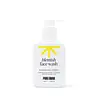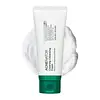What's inside
What's inside
 Key Ingredients
Key Ingredients

 Benefits
Benefits

 Concerns
Concerns

 Ingredients Side-by-side
Ingredients Side-by-side

Water
Skin ConditioningGlycerin
HumectantSodium Cocoyl Glycinate
CleansingSodium Lauroyl Glutamate
Corn Starch Modified
AbsorbentGlycolic Acid
BufferingLactic Acid
BufferingCocamidopropyl Betaine
CleansingSodium Taurine Laurate
CleansingSalix Alba Bark Extract
AstringentMelia Azadirachta Leaf Extract
Skin ConditioningScutellaria Baicalensis Root Extract
AstringentHouttuynia Cordata Extract
Skin ConditioningLactococcus Ferment Lysate
Skin ConditioningSalicylic Acid
MaskingGlycine Soja Protein
EmulsifyingMaltooligosyl Glucoside
Skin ConditioningHydrogenated Starch Hydrolysate
HumectantPentylene Glycol
Skin ConditioningCaprylhydroxamic Acid
Glyceryl Caprylate
EmollientWater, Glycerin, Sodium Cocoyl Glycinate, Sodium Lauroyl Glutamate, Corn Starch Modified, Glycolic Acid, Lactic Acid, Cocamidopropyl Betaine, Sodium Taurine Laurate, Salix Alba Bark Extract, Melia Azadirachta Leaf Extract, Scutellaria Baicalensis Root Extract, Houttuynia Cordata Extract, Lactococcus Ferment Lysate, Salicylic Acid, Glycine Soja Protein, Maltooligosyl Glucoside, Hydrogenated Starch Hydrolysate, Pentylene Glycol, Caprylhydroxamic Acid, Glyceryl Caprylate
Glycerin
HumectantLeptospermum Scoparium Leaf Extract
Skin ConditioningWater
Skin ConditioningSodium Cocoyl Glycinate
CleansingSodium Lauroyl Glutamate
1,2-Hexanediol
Skin ConditioningLaminaria Japonica Extract
Skin ProtectingEclipta Prostrata Leaf Extract
Skin ConditioningHamamelis Virginiana Extract
AntiseborrhoeicMelaleuca Alternifolia Leaf Oil
AntioxidantHydrogenated Lecithin
EmulsifyingCoco-Betaine
CleansingSalicylic Acid
MaskingAcrylates/C10-30 Alkyl Acrylate Crosspolymer
Emulsion StabilisingCitric Acid
BufferingBeta-Glucan
Skin ConditioningFructooligosaccharides
HumectantGluconolactone
Skin ConditioningHydrolyzed Hyaluronic Acid
Humectant4-Terpineol
MaskingZinc PCA
HumectantCapryloyl Salicylic Acid
ExfoliatingHydroxyacetophenone
AntioxidantEthylhexylglycerin
Skin ConditioningGlycerin, Leptospermum Scoparium Leaf Extract, Water, Sodium Cocoyl Glycinate, Sodium Lauroyl Glutamate, 1,2-Hexanediol, Laminaria Japonica Extract, Eclipta Prostrata Leaf Extract, Hamamelis Virginiana Extract, Melaleuca Alternifolia Leaf Oil, Hydrogenated Lecithin, Coco-Betaine, Salicylic Acid, Acrylates/C10-30 Alkyl Acrylate Crosspolymer, Citric Acid, Beta-Glucan, Fructooligosaccharides, Gluconolactone, Hydrolyzed Hyaluronic Acid, 4-Terpineol, Zinc PCA, Capryloyl Salicylic Acid, Hydroxyacetophenone, Ethylhexylglycerin
Ingredients Explained
These ingredients are found in both products.
Ingredients higher up in an ingredient list are typically present in a larger amount.
Glycerin is already naturally found in your skin. It helps moisturize and protect your skin.
A study from 2016 found glycerin to be more effective as a humectant than AHAs and hyaluronic acid.
As a humectant, it helps the skin stay hydrated by pulling moisture to your skin. The low molecular weight of glycerin allows it to pull moisture into the deeper layers of your skin.
Hydrated skin improves your skin barrier; Your skin barrier helps protect against irritants and bacteria.
Glycerin has also been found to have antimicrobial and antiviral properties. Due to these properties, glycerin is often used in wound and burn treatments.
In cosmetics, glycerin is usually derived from plants such as soybean or palm. However, it can also be sourced from animals, such as tallow or animal fat.
This ingredient is organic, colorless, odorless, and non-toxic.
Glycerin is the name for this ingredient in American English. British English uses Glycerol/Glycerine.
Learn more about GlycerinSalicylic Acid (also known as beta hydroxy acid or BHA) is a well-known ingredient for treating skin that struggles with acne and clogged pores. It exfoliates both the skin's surface and deep within the pores to help clear out buildup, control oil, and reduce inflammation.
Unlike AHAs (alpha hydroxy acids), salicylic acid is oil-soluble. This allows it to penetrate into pores which makes it especially effective for treating blackheads and preventing future breakouts.
Salicylic acid is also known for its soothing properties. It has a similar structure to aspirin and can calm inflamed or irritated skin, making it a good option for acne-prone skin that is also sensitive.
Concentrations of 0.5-2% are recognized by the U.S. FDA as an over-the-counter topical acne product.
It can cause irritation and/or dryness if one's skin already has a compromised moisture barrier, so it's best to focus on repairing that before introducing this ingredient into your routine.
While salicylic acid does not increase sun sensitivity, it’s still important to wear sunscreen daily to protect your skin.
If you are looking for the ingredient called BHA or Butylated Hydroxyanisole, click here.
Learn more about Salicylic AcidSodium Cocoyl Glycinate is a cleansing agent. It can be naturally derived or synthetically-created.
As a surfactant, it helps clean your skin by gathering dirt, oil, and other pollutants to be rinsed away more easily.
Sodium Lauroyl Glutamate is the sodium salt from the lauric acid of glutamic acid.
It is a surfactant and helps cleanse the skin. Surfactants gather oil, dirt, and other pollutants from your skin so they may be washed away easily.
Water. It's the most common cosmetic ingredient of all. You'll usually see it at the top of ingredient lists, meaning that it makes up the largest part of the product.
So why is it so popular? Water most often acts as a solvent - this means that it helps dissolve other ingredients into the formulation.
You'll also recognize water as that liquid we all need to stay alive. If you see this, drink a glass of water. Stay hydrated!
Learn more about Water